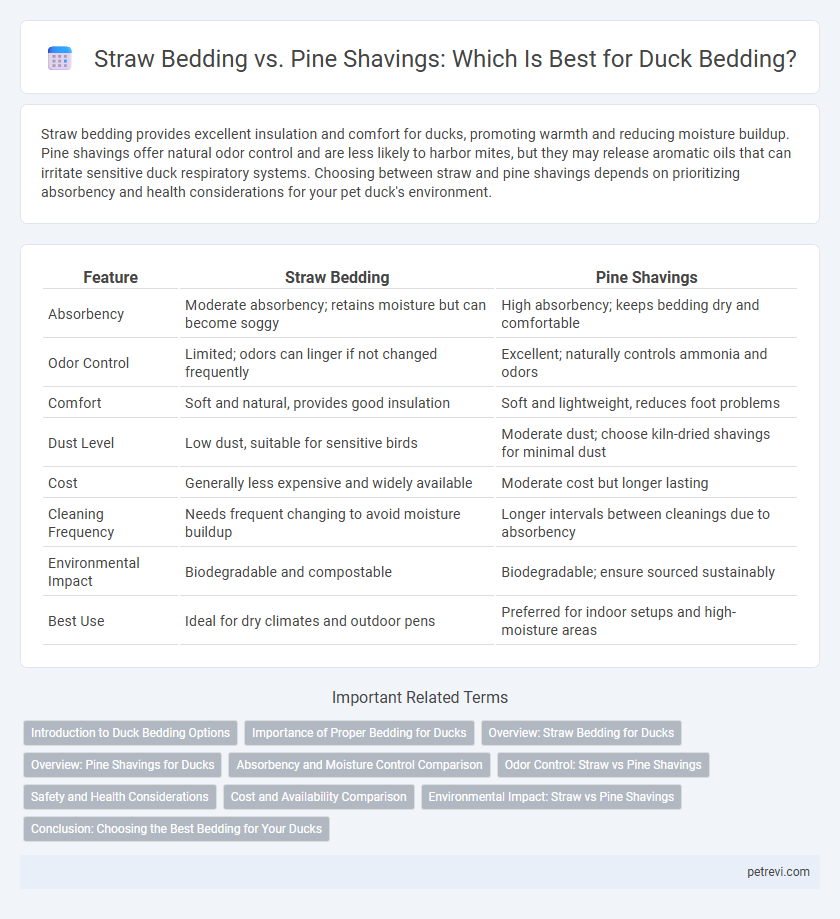Straw bedding provides excellent insulation and comfort for ducks, promoting warmth and reducing moisture buildup. Pine shavings offer natural odor control and are less likely to harbor mites, but they may release aromatic oils that can irritate sensitive duck respiratory systems. Choosing between straw and pine shavings depends on prioritizing absorbency and health considerations for your pet duck's environment.
Table of Comparison
| Feature | Straw Bedding | Pine Shavings |
|---|---|---|
| Absorbency | Moderate absorbency; retains moisture but can become soggy | High absorbency; keeps bedding dry and comfortable |
| Odor Control | Limited; odors can linger if not changed frequently | Excellent; naturally controls ammonia and odors |
| Comfort | Soft and natural, provides good insulation | Soft and lightweight, reduces foot problems |
| Dust Level | Low dust, suitable for sensitive birds | Moderate dust; choose kiln-dried shavings for minimal dust |
| Cost | Generally less expensive and widely available | Moderate cost but longer lasting |
| Cleaning Frequency | Needs frequent changing to avoid moisture buildup | Longer intervals between cleanings due to absorbency |
| Environmental Impact | Biodegradable and compostable | Biodegradable; ensure sourced sustainably |
| Best Use | Ideal for dry climates and outdoor pens | Preferred for indoor setups and high-moisture areas |
Introduction to Duck Bedding Options
Straw bedding offers natural insulation and moisture absorption, making it a traditional choice for duck enclosures, while pine shavings provide superior odor control and are less likely to harbor mold. Selecting the right bedding impacts duck health by influencing cleanliness, comfort, and respiratory conditions. Understanding the benefits and limitations of straw and pine shavings aids in creating an optimal environment for duck welfare and productivity.
Importance of Proper Bedding for Ducks
Proper bedding for ducks is crucial to maintain their health, comfort, and hygiene, directly impacting their growth and egg production. Straw bedding offers excellent insulation and moisture absorption, reducing the risk of bacterial infections and keeping ducks dry. Pine shavings provide a soft, absorbent surface but may release aromatic oils that can irritate ducks' respiratory systems, making straw the preferred option for optimal duck welfare.
Overview: Straw Bedding for Ducks
Straw bedding provides excellent insulation and comfort for ducks, helping to maintain warmth in colder environments. Its natural composition allows for good moisture absorption and easy cleanup, reducing the risk of mold and bacteria buildup. Straw is also less dusty than pine shavings, making it a healthier choice for ducks' respiratory systems.
Overview: Pine Shavings for Ducks
Pine shavings are a popular choice for duck bedding due to their excellent absorbency and natural scent, which helps control odors in duck housing. They provide a soft, comfortable surface that reduces the risk of foot sores and respiratory issues common in ducks. Compared to straw, pine shavings offer better moisture control, making them a hygienic and practical option for maintaining a clean environment.
Absorbency and Moisture Control Comparison
Straw bedding offers moderate absorbency but tends to retain moisture, which can lead to damp conditions harmful to duck health. Pine shavings provide superior moisture control due to their high absorbency and natural antimicrobial properties, helping maintain a dry and hygienic environment. Choosing pine shavings over straw reduces odors and minimizes the risk of infections in duck enclosures.
Odor Control: Straw vs Pine Shavings
Pine shavings provide superior odor control for duck bedding due to their natural antimicrobial properties that inhibit bacterial growth responsible for unpleasant smells. Straw tends to retain moisture more, leading to faster odor buildup and potential health risks for ducks. Choosing pine shavings enhances ventilation and absorbs moisture more effectively, maintaining a cleaner, fresher environment.
Safety and Health Considerations
Straw bedding provides a natural, dust-free environment that minimizes respiratory issues in ducks, promoting overall respiratory health. Pine shavings contain aromatic oils that can cause respiratory irritation and potentially toxic effects in ducks, making them less suitable for long-term use. Choosing straw bedding reduces the risk of ammonia buildup and skin irritation, ensuring a safer and healthier habitat for ducks.
Cost and Availability Comparison
Straw bedding for ducks generally offers a lower cost option compared to pine shavings, with prices varying based on region and supplier availability. Pine shavings, while often more expensive, provide consistent quality and are widely available at farm supply stores and online retailers. Both materials are accessible year-round, but straw may fluctuate in price and availability depending on the harvest season and local agricultural production.
Environmental Impact: Straw vs Pine Shavings
Straw bedding for ducks is biodegradable and decomposes quickly, making it an eco-friendly choice that reduces landfill waste. Pine shavings, while also biodegradable, can release aromatic compounds that may affect indoor air quality and require careful sourcing to avoid deforestation. Choosing straw supports sustainable farming practices by utilizing crop residues, whereas pine shavings often depend on wood from commercial forestry operations.
Conclusion: Choosing the Best Bedding for Your Ducks
Straw bedding offers excellent insulation and absorbency, making it a cost-effective choice for keeping ducks warm and dry. Pine shavings provide superior odor control and are less likely to harbor mold or mites, promoting a healthier environment. Selecting the best bedding depends on balancing warmth, cleanliness, and potential allergens to ensure optimal duck comfort and health.
Straw Bedding vs Pine Shavings for Duck Bedding Infographic

 petrevi.com
petrevi.com